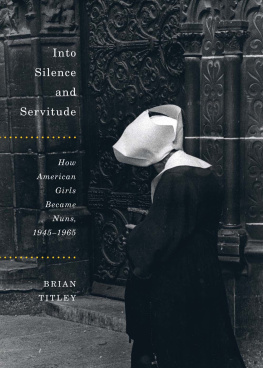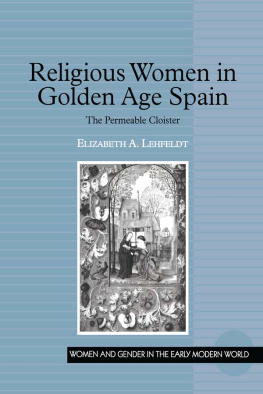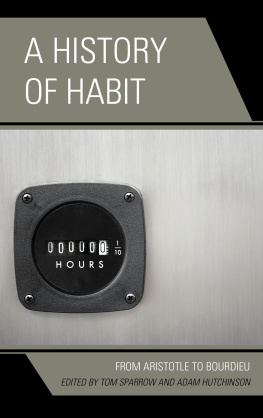Contents
Landmarks


Table of Contents
To my parents,
Bill and Kathy,
for teaching me the important things,
and for so much Joy
Acknowledgments

I have been privileged to meet and work with extraordinary women religious. A few have become my close friends, but all are admired. These women have inspired me to grow in faith and in love, two things that they seem to exhibit in larger-than-life proportions each day in their work with the sick, the imprisoned, the marginalized, and the forgotten. Though my book focuses on a material artifact from their lives, I hope the reader will catch a glimpse of the remarkable courage and compassion that Catholic nuns have exhibited in every era of their history.
I have relied on contemporary women religious for much of my information, and I wish to thank those individuals who contributed specific resources, suggestions, insights, and explanations. Many sisters requested not to be specifically acknowledged, so I offer my thanks to those anonymous participants, as well as to the following: Sr. Maryalice Jacquinot, IHM; Sr. Mary Grace, Sisters of Charity of Our Lady, Mother of the Church; Sr. Beth Rindler, SFP; Sr. Theresa and Sr. Wilemina, Oblates of Mary, Queen of the Apostles; Mother Mary Patrick, AMM; Sr. Beth Murphy, OP; Sr. Miriam D. Ukeritis, CSJ; Sr. Marjorie Hamilton, RGS; Sr. Margaret Truran, OSB; Sr. Mary Loretta, Sisters of Life; Sr. Mary Elizabeth, Sisters of Life; Sr. Margaret Campbell, SNJM; Sr. Mary Anne Foley, CND, Ph.D.; Sr. Elizabeth McDonough, OP; Sr. Barbara Anne of CSMWR; Sr. Carole Mary Capoun, CSSF; Sr. Barbara Garland, SC; Sr. Alma Mary Anderson, CSC, Sr. Agnes Gleeson, RSM; Sr. Winifred, SC; Sr. Andrew Persing, OSF; Sr. Marjorie Hamilton, RGS; Sr. Karen M. Kennelly, CSJ; Sr. Leonelle; Suzanne Delaney, IHM; Maria Hill, CSJ; Amy Levinthal; Reneta E. Webb, Ph.D., CAE; Arlene Ronollo, SSJ; Sr. Joan Miller, OSF; Sr. Therese Deveau, SMSM; and Sr. Gail Worcelo, Sisters of the Earth.
I wish to thank the following archivists and superiors of communities who provided me with materials and information from their private archival collections: Sr. Kathleen McNulty, IHM, Archivist, Congregation of Sisters, Servants of the Immaculate Heart of Mary; Ms. Loretta Zwolak Greene and Mr. Peter F. Schmid, CA, Sisters Providence Archives, Seattle, Washington; Sr. Genevieve Keusenkothen, Daughters of Charity of St. Vincent De Paul, West Central Province Archives, St. Louis, Missouri; Sr. Julie McGuire, CSC, Sisters of the Holy Cross; Ms. Patricia Jacobsen, Archives of the Little Company of Mary, Province of the Holy Spirit, Hurtsville, Australia; Ms. Cindy Swanson, Sisters of Bon Secours USA; Sr. Helen Streck, Adorers of the Blood of Christ, Wichita, Kansas; Sr. M. H. Sisters of the Good Shepherd, Province of Mid-North America, St. Louis, Missouri; Congregation of the Daughters of St. Francis of Assisi, American Province, Lacon, Illinois; Ms. Lisa Jacobson and Sr. Martha Bourne, Maryknoll Mission Archives, Maryknoll, New York; Monastery of St. Gertrude, Cottonwood, Idaho; Sr. Rita Rose Leding, Daughters of St. Mary of Providence, Chicago, Illinois; Mother M. Carmel, Sisters of the Presentation of the Blessed Virgin Mary, Watervliet, New York; Dr. Stephanie Morris; Sisters of the Blessed Sacrament; Sr. Donna Marie Kessler, Franciscan Sisters of Christian Charity; Sr. Mary Rose Chinor, Handmaids of the Sacred Heart of Jesus, Mary and Joseph; Sr. Antoinette Cedrone, Daughters of Mary Help of Christians-Salasian Sisters of St. John Bosco; Sr. Clare, The Community of Franciscan Sisters of the Renewal; Sr. Mary Laurence Hanley, Sisters of St. Francis, Syracuse, New York; Phyllis Ann Lavalle, Sisters of the Most Holy Trinity, Euclid, Ohio; Sr. M. Nrimala, Missionaries of Charity, Calcutta, India; Sr. Carm Ternes, OSB, Monastery of St. Gertrude, Cottonwood, Idaho; Sr. M. Vaclava Ballon, Congregation of the Daughters of St. Francis of Assisi, American Province; Sr. M. Prostasia Hofstetter, Franciscan Sisters of Mary Immaculate, Amarillo, Texas; Sr. Mary Emmanuel, Daughters of Our Mother of Peace, Queen of Heavenly Solitude; and Sr. Mary de Paul, OP, Hawthorne Dominicans, Hawthorne, New York.
I would also like to thank Ken Cholewa; Fr. Juan Diego, OP; Dr. Desiree Koslin; Catherine Richardson; Brother Anthony of Adoramus House; the librarians at Marywood University, the University of Scranton, and the Albright Memorial Library, Scranton, Pennsylvania; members of the e-mail discussion groups Sister-L and CTAC; Sisters of Perpetual Indulgence; Fr. Thomas P. McCarthy; Dr. Cordelia Warr; Professor Giancarlo Rocca; Fr. Jay A. Finelli; Elizabeth Cardinal; Donna M. Steichen; Dr. Carol Coburn; Julia Ann OSullivan; Hugh Charles Martin; Lisa Jacobson; Dr. Dean Hoge; Fr. Anthony M. Patalano, OP; Dan Paulos, Fr. Augustine Thompson, OP, Ph.D.; Jim, Marilyn, and Michelle Shields; Joanne Francis; Amanda Powell; Maggie Hoerl, ACWR National Office; Maria Orzel, Diocese of Scranton; Dr. Margaret Susan Thompson; Dr. Asuncion Lavrin; Dr. Kathryn Burns; Mary Elizabeth Brown; Yvonne Goddard; Fr. Albert DiIanni; Susan Lloyd; Dr. Susan Michelman; Dr. Sarah Cline; Dr. Roger Finke; Dr. Patricia Ranft; Nicola DeGrandi; Fr. Michael Morris, OP, Ph.D.; Mary B. Dolan; Donna Sartor; Dr. Scott Hahn; Bridget Brewster; Carol Proietti, SSA; Dr. Marian Horvat; Duncan Maxwell Anderson; Barbara James; and Dr. Eric Plumer.
I would like to offer special thanks to Sr. Mary Catharine Perry, OP, and to Sr. Annmarie Sanders, IHM, for their extensive input and for connecting me to other resources; to Charles Coulombe for conceiving the idea for the book; to Dr. John P. Zmirak for his significant support; and to my agent, Christy Fletcher at Carlisle & Company, and Eric Major, Elizabeth Walter, Frances OConnor, and Michelle Rapkin at Doubleday Religion for bringing the book to life.
Finally, I wish especially to acknowledge Martina Ciaruffoli Schuler for her expertise in clothing science and for contributing hundreds of hours of essential research for this book; Ray for his invaluable advice and editorial assistance; Rev. Calvin Goodwin, FSSP, for review of the manuscript; and my entire family for their help and encouragement, particularly Jeannette for providing French translation, and Eric for his incalculable contributions.
Introduction
For some, the Catholic nuns habit represents an outmoded Church and an obsolete way of life. Yet the distinctive black-and-white garb is a nostalgic image held dear by millions, serving as a universal representation of holinessa mysterious and evocative cultural icon that has defined the Catholic sister for nearly two thousand years.
Because of the universality of the Catholic Church, the image of the nun is a familiar one, and whether Catholic sisters taught us in school or not, their lifestyles and attire fascinate us. When we speak of nuns, we tend to think of starched white linen headbands and wimples, long heavy woolen dresses, and flowing black veils. Although this form of attire is now more the exception than the rule, it continues to define our conception of the Catholic sister. Films and advertisements almost invariably use the habit to portray women religious, and the Church likewise uses the image because of the reaction it evokes from aspirants to convent life and potential donors alike. The habit lingers on because there is simply nothing as visually effective to take its place.











